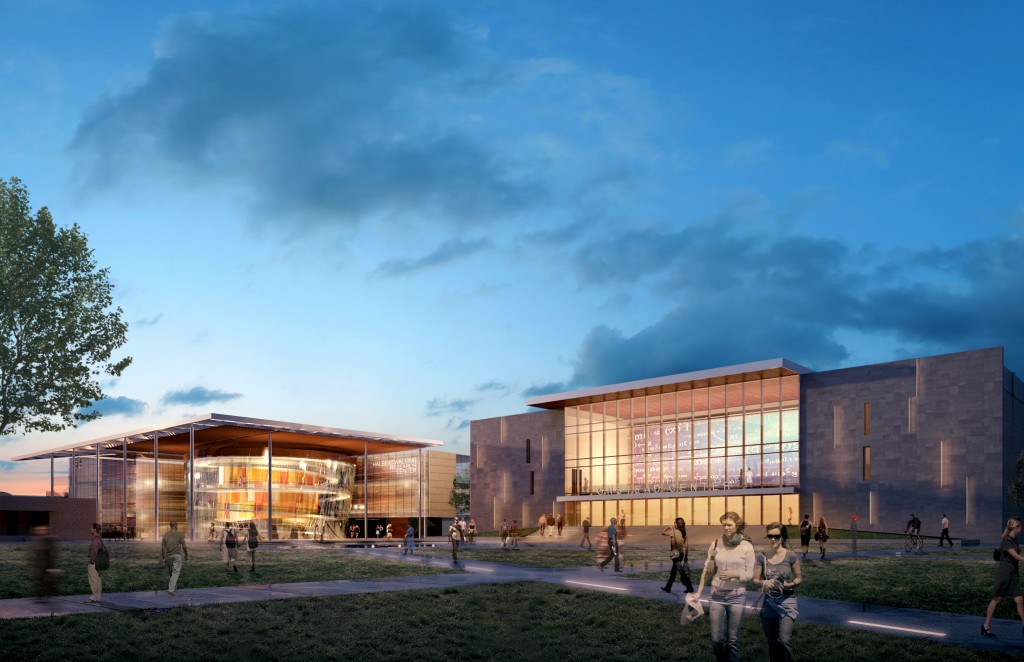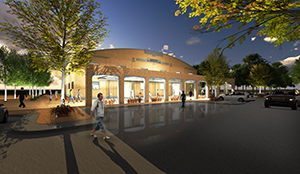
Foster Science Building will be transformed to the Robert R. Onstead Center for Science and Humanities. Chambers will be torn down and replaced by The Halbert- Walling Research Center. (Via renderings)
Construction will begin on the development of three science facilities on campus as a result of gifts totaling $30 million from three donors.
As part of the development, Foster Science Building will be transformed to become the Robert R. Onstead Center for Science and Humanities. Chambers Hall will be torn down and a new facility, the Halbert-Walling Research Center, will replace it. Walling Lecture Hall will be torn down, as well. Finally, the project will dramatically renovate the interior of Bennett Gymnasium.
The Halbert-Walling Research Center and the Onstead Center will feature laboratories, classrooms, offices and areas supporting research and education for departments in both the sciences and humanities.
Dr. Phil Schubert, president of the university, said the new science faculties will accommodate some of the most rapidly growing disciplines in the last decade.
“We’re taking areas of excellence at ACU who have been operating in outdated facilities, and now providing state-of-the-art facilities that will continue to allow them to grow and take that excellence to another level,” Schubert said. “It’ll help us attract faculty. It’ll help us attract students.”
Dr. Robert Rhodes, provost, said new facilities have been needed for some time.
“We’re looking at the longstanding need for new science facilities,” he said. “We have programs that have outpaced where they reside. We have programs that have a great reputation that have a long history preparing individuals in a variety of science fields. But we’re starting to really feel the age of our facilities.”
The buildings that currently house the science department place limitations on what professors and students are able to do, said Dr. Greg Straughn, dean of the College of Arts and Sciences.

Bennett Gymnasium will be remodeled into a facility for the Department of Engineering and Physics. (Via renderings)
For example, nursing students are required to take the anatomy and physiology lab offered by the Department of Biology, but the nursing program has been rapidly growing. The number of students allowed to take the lab is limited by the room, which can fit only 16 to 18 people.
“There’s a whole lot more people who need that class, so we are having to have multiple, multiple sections of that class to meet all that need,” Straughn said. “If we expanded the size, we would be more efficient.”
Straughn said smaller classrooms means professors having to teach more sections and, as a dean, he’s wary of overworking faculty. He also said safety can be improved in the science facilities, like the vent hoods not working properly.
In Chambers, classrooms and offices are also small, and the building is not Americans with Disabilities Act-friendly.
“If we are able to move into a much more conducive atmosphere for learning, mentoring and collegiality, that’s going to position the university well for 100 years,” Straughn said.
Dr. Jeff Arrington has spent 25 years in the Department of Engineering and Physics, both in administration and teaching.
“Faculty members want facilities that support opportunities for more students to be involved with undergraduate research and facilities that support teaching some of the modern breakthroughs in their disciplines, and facilities that demonstrate ACU’s commitment to educating students well in the sciences,” Arrington said.
Arrington said the ACU’s growing engineering program is in need of a space equipped for learning in that field.
“The excitement is for the first time ever in our school history we’ll get to have enough space to allow our faculty and students to research together on campus in a way that’s never been done before,” said Dr. Rusty Towell, chair of the Department of Engineering and Physics.
Work will begin first on Bennett Gym, pending Board of Trustees approval, this semester with plans to be finished by fall 2014. Bennett will be renovated to house state-of-the-art laboratories and classrooms for the engineering program, but the original facade of Bennett will be maintained.
In the fall semester, Bennett will house engineering and physics labs and lecture courses until the completion of the other two buildings.
The Halbert-Walling Research Center and the Onstead Center’s construction plans are being finalized, but construction is planned to begin late this summer or early next fall semester, Schubert said, but construction will not proceed until they receive all of the funding necessary.
More than the sciences will be affected by renovations. During construction, several departments will be displaced including the science departments, mathematics, psychology and languages and literature.
Two thirds of of the College of Arts and Sciences will receive new offices, Arrington said, and that idea thrills him.
“There are leaders in the past and present that have had this vision and asked for this support for years,” Arrington said. “I think that our department chairs and senior faculty that have been telling us what we could do if we had improved facilities – I think their vision and persistence is bearing fruit here.”
Arrington said he’s surprised at how quickly this project has been moving already.
“People have been dreaming about this for over 20 years,” Arrington said.
